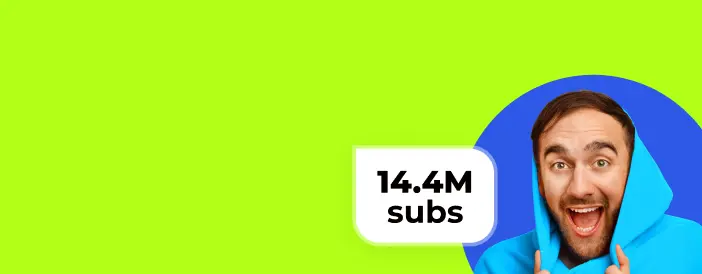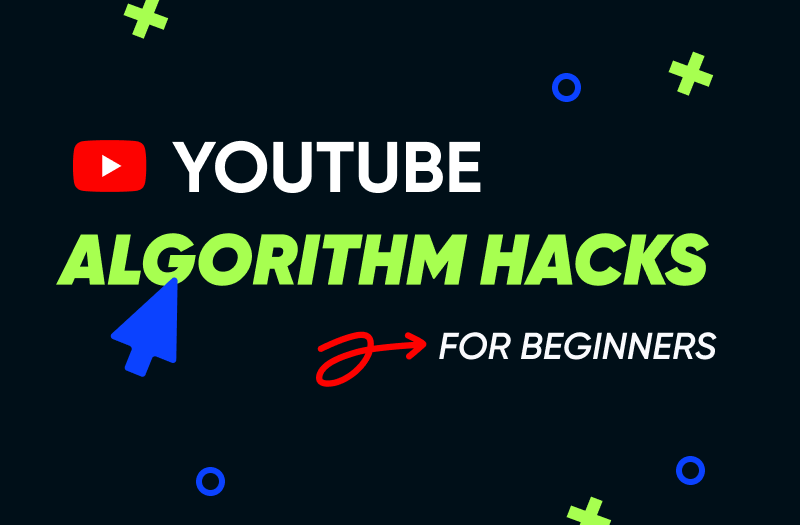
For creators of all sizes, there comes a point when the idea of launching a second channel becomes attractive—whether it’s to explore new ideas, find a different audience, or expand your brand. In this article, we’ll help you figure out if it’s time for that second channel and what benefits you can gain from it.
Branching Out
You will eventually evolve beyond just one niche. It can be as simple as you getting tired of making repetitive content, or your audience craving something different from what you’re already doing. That’s when a second YouTube channel might be in order. Say you’ve built a thriving cooking channel, but now you’re obsessed with fitness. Combining both might be confusing and ‘out of nowhere’ for your loyal audience.
A new channel can allow you to create targeted content that appeals to a distinct niche without alienating your existing viewers.
As another example, you might be a thriving tech reviewer and your audience is also clamoring for tutorials or gaming content, it’s time to consider separating those into their own channel. This ensures each channel serves a focused purpose, making it easier for viewers to find the content they’re looking for.
Content is Becoming Too Diverse
Being a versatile creator is awesome. You can game one day, vlog the next, throw in a cooking tutorial, and cap it off with a travel vlog. But as fun as that sounds for you, your viewers might not agree, because to them it might look like pure chaos compressed in a YouTube channel. Eventually, your subscribers might tune out because they came for one thing and are being bombarded with something completely different.
If your content has become too eclectic, launching a second channel can help you compartmentalize. Keep the gaming on one channel and the vlogging on another. It gives your audience a streamlined experience, where they know exactly what they’re signing up for when they hit that subscribe button. Plus, it’s easier for you to cater to your different fan bases with more targeted content. You’re not sacrificing creativity, just giving it a more structured home.
Having separate channels for different types of content also means better metrics and more precise audience targeting. When your content is focused, YouTube’s algorithm is better able to suggest your videos to the right viewers, which could lead to improved engagement, retention, and subscriber growth on both channels. Essentially, more clarity for your audience, and better performance for you.
AIR Media-Tech is the ultimate space for content creators, offering tools and solutions for every challenge you might face. We help creators around the globe reach new heights with our advanced technology and deep expertise. Just reach out to us to join the AIR Community and get started!
You’re Hitting a Growth Plateau
There’s nothing more frustrating than working hard on your content, only to see your subscriber count flatline. If you’ve been stuck in the same place for a while, it’s a signal that something needs to change. Of course, you could choose to audit with AIR Media-Tech and shake up your main channel’s content. Or instead of shaking up your primary channel with experimental content that may or may not confuse your current audience, why not start fresh with a second channel?
Launching a second channel can reignite your passion and creativity. It’s like getting a blank canvas where you can explore new ideas without the fear of disrupting your established content. You might have a secondary passion that doesn’t quite fit on your main channel, like cooking, music, or DIY projects—this is your chance to pursue it while keeping your original channel intact. Not only can this help you reach a brand-new audience, but it can also revitalize your enthusiasm for creating.
And then there’s the potential for increased growth. When you create a second channel, you’re opening up more doors for ad revenue, sponsorships, and brand deals. Sponsors love creators who can appeal to different niches because it gives them more opportunities to target various markets. The more channels you have, the more exposure you get to diverse audiences, which means more potential for partnerships.
Even more importantly, a second channel allows you to cross-promote. Your established audience can help jumpstart your new venture, while your new channel can send fresh eyes back to your original content. You’re essentially building an ecosystem of interconnected content, all feeding into each other, and growing together.
You Want to Explore a Different Language
YouTube is not just an English-speaking playground. It’s a global platform, and if you’ve already established a solid audience, exploring a different language could be your next power move. Sure, captions and translations are a good start, but there’s something about hearing a video in your native language that hits different. It feels personal, and, most importantly, accessible.
Creating a fully dubbed or translated channel in another language shows your commitment to engaging with your international audience on a deeper level. Imagine you’re a popular tech reviewer in English, but you notice a growing fanbase in Spanish-speaking countries. Rather than simply adding subtitles, what if you create a second channel where your content is entirely dubbed in Spanish? This localized approach can attract more native speakers, who might otherwise be put off by the language barrier.
Not only does this help you expand into new markets, but it also makes your content more culturally relevant. Plus, native-language content tends to perform better in YouTube’s algorithm within that region, giving you more visibility and engagement in new demographics. This strategy could potentially double your impact, with one channel thriving in English-speaking markets and another gaining traction in other parts of the world.

You Want to Keep Personal and Professional Content Separate
Blurring the lines between personal and professional content can be risky. What starts as a fun mix of vlogs, tutorials, and personal life updates might confuse your audience over time. While some of your die-hard fans might appreciate this behind-the-scenes look into your life, others might just be left disinterested.
One channel can house your professional, polished content—whether that’s product reviews, tutorials, or interviews. The other? That’s where you get to let loose with more personal, casual videos like vlogs, travel diaries, or day-in-the-life updates. Your professional channel stays focused and on-brand, while your personal channel offers a deeper, more authentic glimpse into your life for those who want it.
And you can still cross-promote between the two channels. Your audience on the professional channel can hop over to the personal one if they’re interested in seeing more of your personality and day-to-day life. Meanwhile, your personal channel followers might end up engaging with your professional content once they get to know you better.
Keeping Channels Under One Email or Moving Them to Another Account
You can manage multiple YouTube channels under one email, which is convenient, but there are times when moving a channel to another account just makes sense. For example, if you’re collaborating with a partner or team, transferring the channel lets them manage it without giving access to your entire account.
It’s also helpful for keeping work and personal projects separate or improving security by placing the channel under a more secure account. And if you’re selling the channel or rebranding, transferring ownership is the easiest way to make the switch without losing your subscribers, videos, or settings.
Watch this quick video to see how it’s done: How to Transfer Your YouTube Channel:
Your Main Channel Has Grown Too Large to Pivot
Success on YouTube is a blessing, but it can also come with its own set of challenges. When you’ve amassed a large following, the stakes get higher. Your audience subscribes for a specific type of content, and making sudden or significant changes can feel like a gamble. Pivot too hard, and you might alienate the very viewers who helped build your channel in the first place. But what if you’re itching to explore new topics or creative directions? That’s where a second channel becomes the perfect solution.
Let’s say you’ve built a massive following doing makeup tutorials, but now you’re really passionate about something else entirely (or want to suddenly start posting animations) and want desperately to create different content. If you suddenly start posting those videos on your main channel, your makeup-loving audience might disengage. Instead of risking your primary channel’s success, you can create a second channel dedicated solely to your new interest. This allows you to start fresh without jeopardizing the foundation you’ve built.
With this second channel, you’re free to experiment, explore, and evolve without the fear of alienating your original fanbase. It’s also a smart way to diversify your presence on YouTube.
In short, when your main channel becomes too big to make drastic changes, a second channel allows you to branch out into new areas without losing the core of what made you successful in the first place.
You’re Expanding Your Brand
As a content creator, your personal brand is the heart of your YouTube channel. It’s what your audience connects with, and it’s often a mix of your personality, expertise, and creativity. But what happens when you’re ready to expand that brand into a full-fledged business or launch a new product line? Suddenly, your once-personal channel might not be the best place to focus on marketing campaigns, product promotions, or business updates.
Creating a second channel specifically for your business or product line allows you to build a distinct identity for that side of your brand. Your original channel remains the go-to spot for your audience who loves you for you, while your business channel becomes a hub for everything related to your entrepreneurial journey.
Additionally, by keeping business and personal content separate, you avoid the risk of diluting your personal brand. Your audience can continue enjoying the content they originally subscribed for without feeling like they’re constantly being sold to. Meanwhile, your business channel can become a powerful tool for growing your brand, reaching new customers, and showcasing your expertise in your industry. It’s a win-win: your personal content stays true to its roots, while your business gets the spotlight it deserves.
You’re Targeting Different Demographics
If your content is beginning to appeal to different age groups or demographics, it might be time to consider separating your channels. Let’s say you started as a family vlogger, sharing fun, lighthearted videos with your kids and pets. Over time, though, you’ve realized that you want to explore more adult-themed content—perhaps delving into career advice, financial tips, or fitness journeys. Suddenly, you’re balancing two very different audiences: kids who enjoy watching your playful family moments, and adults who are seeking real-world advice. Mixing these two groups on a single channel can be tricky.
More importantly, if your content appeals to children, you need to be aware of YouTube's strict guidelines for kid-friendly content. The platform’s COPPA (Children's Online Privacy Protection Act) compliance means that content geared towards kids is subject to different advertising rules, limited engagement features, and stricter content guidelines. Keeping kid-centric content on a separate channel ensures that you stay compliant while providing the appropriate content experience for your younger viewers.
For example, a channel targeting children might focus on animated storytelling, educational videos, or toy unboxing, while a second channel for adults could dive into DIY projects, personal development, or in-depth tutorials. By keeping these channels separate, you ensure that each demographic receives quality content.
Moreover, this separation allows you to better optimize your channel strategies. Each channel can be fully optimized for its respective demographic, maximizing engagement and growth potential without confusing or alienating either group.
Starting a second YouTube channel isn’t a decision to take lightly, but when done for the right reasons, it can unlock new growth, creativity, and opportunities for you as a creator. If your content, audience, or goals are expanding, a second channel might be the next best step in growing your YouTube empire.



